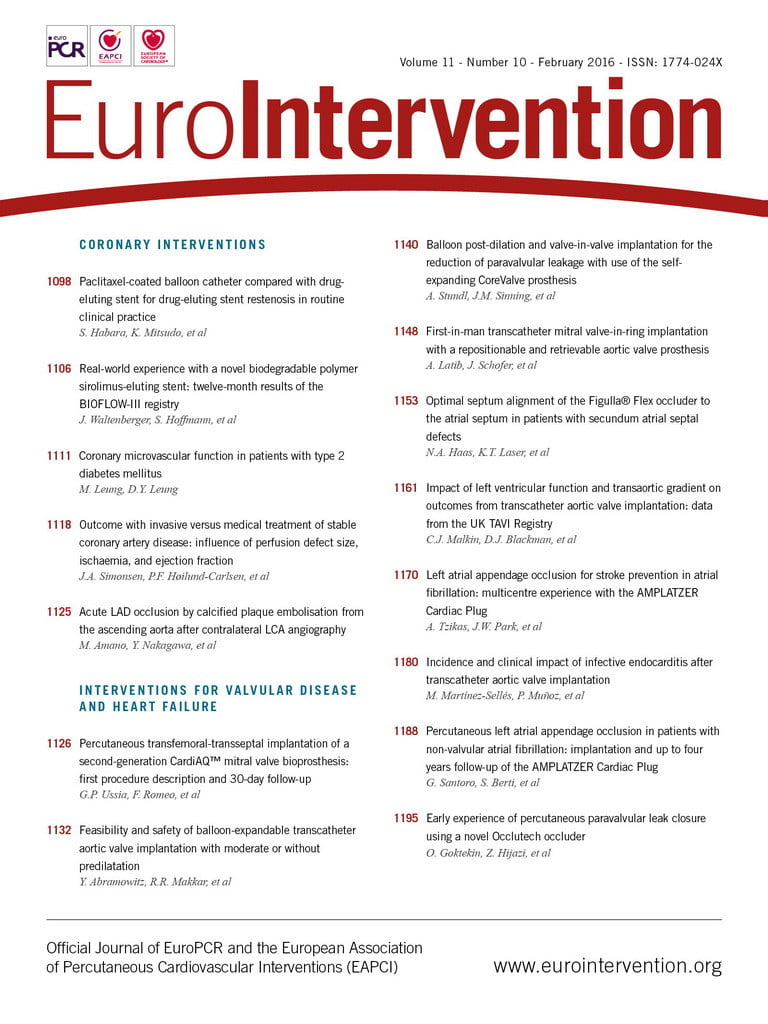
“La fonction d’un écrivain est d’appeler un chat un chat. Si les mots sont malades, c’est à nous de les guérir. Au lieu de cela, beaucoup vivent de cette maladie.” – Jean-Paul Sartre
Sometimes you advance by taking a step back. The current edition of EuroIntervention illustrates this point in the importance of a name, in this case “structural heart”, a relatively new term which appeared in the early days of valve replacement. However, it is clearly a mixed bag, including the valve and the PFO and the left appendage and some congenital abnormalities. Perhaps it might be better to supplant it by the older and more accurate concept of “valvular disease”? I will come back to this idea later in the editorial; for now, let’s take a look at the “structural heart” section of this edition of EuroIntervention, which dominates the publication with nine articles on “structural heart” diagnosis and therapy.
We begin with two editorials, by Samir R. Kapadia and Don Hagler, dealing with paravalvular leak (PVL) and the mitral valve. The analysis of PVL has been central in the field of aortic valve replacement. Last year, Carlos Ruiz organised a meeting under the umbrella of the Academic Research Consortium (ARC), concentrating on PVL, which is definitely a different animal from aortic regurgitation. The VARC group is also struggling to synthesise the diagnosis of PVL made by MRI, echo, angiography, and other techniques, including more dynamic parameters. All this remains a continuing challenge, especially in the way we practise at the present time. Clearly, with the advent of the minimalist approach, without anaesthesia and transoesophageal echo, angiography, at least in the acute phase, is coming back as a down-to-earth technique to assess PVL.
Our third editorial this month is by Vinnie Bapat and deals with mitral valves and rings, offering us a word of caution. For me it is evident that the interventional community has been overwhelmed by a veritable tsunami of devices dealing with the mitral valve. It has been said that there are now more than 40 devices dealing with the mitral pathology, which is an extremely complex issue connected to the myocardium, the papillary muscle and the chordae. We are far from being at the end of our troubles in dealing with this pathology.
EuroIntervention remains at the forefront of innovation in this field, with this issue including first-in-man devices as well as highlighting new developments and techniques. We are proud to have published ahead of print the article which now appears in the current journal, an exceptional premiere, the percutaneous transseptal implantation of a mitral valve prosthesis by Gian Paolo Ussia and colleagues. Another novelty, the article by Yigal Abramowitz et al on the feasibility and safety of balloon-expandable TAVI with moderate or without predilatation is also of great interest, and the description of the first-in-man transcatheter mitral valve in a ring by Azeem Latib et al is fascinating. We also have two remarkable descriptions in this issue of EuroIntervention on PVL closure by Omer Goktekin et al reporting on their early experience using a dedicated occluder. We conclude with a fascinating “How should I treat”, this time about a patient with refractory cardiogenic shock with chronic biventricular heart failure … and mitral regurgitation! I will let you guess which was the final treatment adopted for this patient.
Returning to my initial thoughts, as I contemplated this editorial and took another look at the different sections of our journal, the necessity to untangle the very mixed bag we call “structural heart” became evident. There is, without doubt, a growing need to make a clear distinction between the aortic valve, the mitral valve, the PFO and the left appendage. During the last EuroPCR board meeting, Stephan Windecker, President of the EAPCI, strongly advocated returning to the earlier terminology of “valvular disease” in order to capture and describe better what is happening with the aorta, the mitral valve and the tricuspid valve. Not surprisingly, the whole board agreed with reintroducing the term “valvular disease” and calling a “cat a cat”.
For me, there is no doubt that the future will see this step backwards – at least in terms of vocabulary – with our “structural heart” section re-baptised “valvular heart and PFO and the left appendage”. Whatever it is called, however, one thing is sure: with the quality of our authors and the importance and inherent interest of the topics we treat, whatever the name, we are sure to continue to attract as well as hold the attention of our readers.

